Goat Meat: Your Comprehensive Guide to Nutrition, Benefits, Cooking, and More
Often overlooked in many Western cuisines, goat meat is a culinary treasure enjoyed by billions worldwide. From bustling markets in Asia and Africa to gourmet restaurants in the Caribbean and the Middle East, goat meat stands as a staple, celebrated for its unique flavor and robust nutritional profile. This comprehensive guide will explore everything you need to know about this versatile red meat, including its various names, where to find it, typical prices, impressive health benefits, and an authentic, delicious goat meat recipe to get you started on your culinary journey.
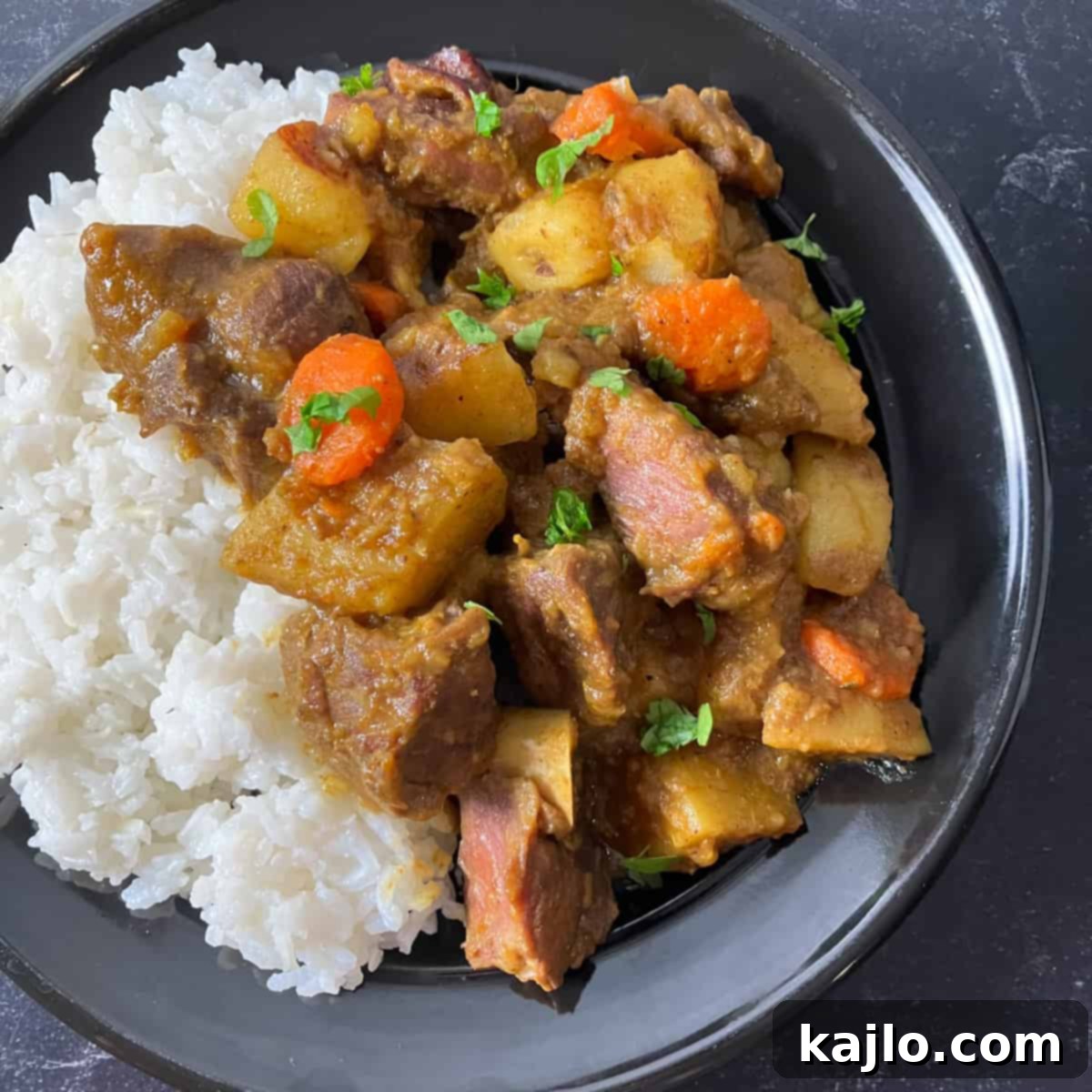
❓
What is Goat Meat Called? Exploring its Global Names
While commonly referred to simply as “goat” in the United States, this nutritious meat boasts a rich lexicon of names across different cultures and culinary traditions. In more upscale gastronomic settings, particularly those influenced by French cuisine, you might encounter it as chevon, derived from the French word for goat. For younger goats, the terminology further diversifies. In Spanish-speaking regions, particularly Mexico and parts of Latin America, the tender meat of a young goat is known as cabrito or chivo. Italians refer to it as capretto. In English-speaking countries, especially in a more general context, baby goat meat is often called kid meat.
It’s worth noting a common point of confusion: the term “mutton.” In the US, mutton typically refers to the meat of adult sheep, while lamb is from younger sheep. However, in many parts of the Caribbean and South Asia, “mutton” is frequently used to refer to goat meat, highlighting the regional variations in culinary language. Understanding these names can enhance your appreciation for goat meat’s global appeal and help you navigate diverse menus.
Is Goat and Lamb the Same? Clarifying the Distinction
A frequent question for those new to goat meat is whether it’s interchangeable with lamb. The answer is a definitive no. Despite both being small ruminants and sharing some culinary similarities, goats and sheep are distinct animal species. A lamb is specifically a young sheep, whereas a young goat is called a kid. While both meats are red meats and can be prepared using similar methods, their flavor profiles and nutritional compositions have subtle differences, which we will explore further.
What Does Goat Meat Taste Like? A Culinary Exploration
The flavor of goat meat is a key aspect of its appeal and often sparks curiosity. It’s generally characterized by a slightly sweet, yet distinctively bold and earthy flavor. Many describe it as having a “gamey” quality, which can vary in intensity depending on the goat’s age, diet, and specific cut. Younger goats (kid meat or cabrito) tend to have a milder flavor, while older goats can be more robust. As a red meat, goat can often be substituted in recipes calling for beef, offering a leaner and sometimes more complex alternative. However, for many, the taste profile of goat meat is more akin to lamb, offering a richer and less greasy experience than beef cattle.
The unique flavor of goat meat is highly prized in cuisines that masterfully blend spices and slow-cooking techniques, allowing its inherent qualities to shine through. Proper preparation, including marination and slow braising, can further tenderize the meat and mellow any strong “gamey” notes, making it incredibly tender and flavorful.
😊
Is Goat Meat Good Eating? A Resounding Yes!
Absolutely! While taste is inherently subjective, goat meat is lauded globally as an excellent and highly desirable food. Its widespread popularity across continents speaks volumes about its deliciousness and versatility. Beyond its rich flavor, goat meat is celebrated for being a remarkably healthy lean protein choice. It offers a substantial nutritional punch without the excessive fat often found in other red meats, making it an ideal inclusion in a balanced diet.
For those seeking to diversify their protein sources or explore new culinary horizons, goat meat presents a fantastic option. Its ability to absorb flavors from marinades and spices, coupled with its tender texture when cooked correctly, makes it a rewarding ingredient for any home cook.
Goat Meat Nutrition: A Powerhouse of Essential Nutrients
Goat meat is not just flavorful; it’s also remarkably nutritious. As a lean red meat, it provides a wealth of essential vitamins and minerals crucial for overall health. Here’s a breakdown of the nutrition information for roasted cooked goat meat, based on a 3-ounce (85-gram) serving, according to Cronometer:
- Calories: 122
- Carbohydrates: 0 gram
- Fiber: 0 grams
- Total Fat: 2.58 grams
- Saturated Fat: 0.79 grams
- Cholesterol: 63.75 mg
- Protein: 23.04 grams
- Thiamin: 5.1% Daily Value (DV)
- Riboflavin: 30.5% DV
- Niacin: 16.8% DV
- Vitamin B12: 16.9% DV
- Choline: 16.4% DV
- Folate: 1.1% DV
- Calcium: 1.4% DV
- Iron: 17.6% DV
- Phosphorus: 17.1% DV
- Potassium: 9.8% DV
- Selenium: 14.3% DV
- Zinc: 29.9% DV
As evident from this profile, goat meat is an excellent source of numerous B vitamins, including Riboflavin (Vitamin B2), Niacin (Vitamin B3), and Vitamin B12. These vitamins play crucial roles in energy metabolism, nervous system function, and red blood cell formation. Furthermore, it’s rich in vital minerals such as iron, which is essential for oxygen transport; phosphorus, important for bone health; selenium, an antioxidant; and highly bioavailable zinc, critical for immune function and wound healing. Incorporating goat meat into your diet can significantly contribute to meeting your daily nutrient requirements. Detailed nutrition for the accompanying goat meat recipe can be found in the printable recipe card below.
Goat Meat Calories: A Lean Protein Choice
With just 122 calories per 3-ounce cooked serving, goat meat stands out as a remarkably low-calorie protein option. This makes it an ideal choice for individuals managing their weight or looking to increase their protein intake without significantly increasing their caloric load. Its leanness is one of its most attractive nutritional features.
Protein in Goat Meat: Fueling Your Body
Each 3-ounce serving of cooked goat meat delivers an impressive 23 grams of high-quality protein. Protein is a fundamental macronutrient essential for building and repairing tissues, producing enzymes and hormones, and supporting overall physiological function. For anyone aiming to boost their intake of lean protein, whether for muscle development, satiety, or general health, goat meat is an exceptional choice. Its complete amino acid profile ensures your body gets all the necessary building blocks it needs.
Does Goat Meat Have Cholesterol? Understanding Dietary Impact
Yes, like most animal-based foods, goat meat does contain dietary cholesterol. A 3-ounce serving of cooked goat meat provides approximately 64 mg of cholesterol. However, it’s important to remember that for most healthy individuals, dietary saturated fat tends to have a more significant impact on blood cholesterol levels than dietary cholesterol itself. Goat meat is relatively low in saturated fat, which positions it as a heart-healthier red meat option when compared to many other red meat varieties.
Does Goat Meat Have Iron? Boosting Your Iron Intake
Absolutely! Goat meat is an outstanding source of iron, a critical mineral for preventing iron-deficiency anemia and supporting healthy blood function. A 3-ounce serving of cooked goat meat supplies 17.6% of the Daily Value (DV) for iron. What makes this even more significant is that the iron found in goat meat is heme iron, which is highly bioavailable—meaning your body can absorb and utilize it much more efficiently compared to non-heme iron found in plant-based foods. If you’re looking to naturally increase your dietary iron intake, goat meat is a superb and delicious choice.
Goat Meat Benefits: Why It’s a Healthy Choice
Beyond its appealing taste, goat meat offers a host of health benefits, making it an excellent addition to a balanced diet. One of its primary advantages is its lean yet high-protein composition. This makes it a versatile ingredient suitable for various dietary patterns, including low-carb, keto, and gluten-free diets (depending on the specific recipe and accompanying ingredients). Its high protein content is also incredibly satiating, helping you feel fuller for longer and potentially aiding in healthy weight management by reducing overall calorie intake.
Goat meat is often regarded as a heart-healthy food, aligning well with dietary recommendations like the Mediterranean diet. Its significantly lower saturated fat content compared to many other red meats contributes to maintaining healthy cholesterol levels and reducing the risk of cardiovascular disease. The iron in goat meat, as mentioned, is heme iron, which is more readily absorbed by the body than the non-heme iron found in cereals and most plant-based sources. Many individuals, myself included, have found that incorporating iron-rich animal proteins like goat and beef into their diet can eliminate the need for iron supplements, contributing to better energy levels and overall vitality.
Furthermore, the rich profile of B vitamins, zinc, and selenium supports a wide array of bodily functions, from immune system strength to neurological health and antioxidant defense. Choosing goat meat not only diversifies your palate but also provides a nutrient-dense option for optimizing your health.
Goat Meat vs. Lamb: A Nutritional Showdown
To highlight the unique nutritional advantages of goat meat, let’s compare it with other popular meats. Here’s a quick nutritional comparison of 3 ounces (85g) of cooked goat versus lamb, beef, and chicken:
| Nutrient | Goat | Lamb | Beef (80/20) | Chicken (with skin) |
|---|---|---|---|---|
| Calories | 122 | 241 | 209 | 190 |
| Carbohydrates (g) | 0 | 0 | 0 | 0 |
| Fiber (g) | 0 | 0 | 0 | 0 |
| Total Fat (g) | 2.58 | 16.7 | 13.55 | 11.38 |
| Saturated Fat (g) | 0.79 | 6.9 | 5.12 | 3.18 |
| Cholesterol (mg) | 63.75 | 82.45 | 71.4 | 64.6 |
| Protein (g) | 23.04 | 21.04 | 20.43 | 20.37 |
| Thiamin (% DV) | 5.1 | 5.7 | 2.4 | 3.2 |
| Riboflavin (% DV) | 30.5 | 12.5 | 8.9 | 7.2 |
| Niacin (% DV) | 16.8 | 28.5 | 23.5 | 31.5 |
| Vitamin B12 (% DV) | 16.9 | 37 | 39.5 | 3.8 |
| Iron (% DV) | 17.6 | 8.5 | 12.2 | 6 |
| Phosphorus (% DV) | 17.1 | 17.1 | 17.4 | 15.2 |
| Zinc (% DV) | 29.9 | 26.5 | 34.4 | 8.2 |
When comparing goat meat to lamb, the differences are quite striking. Lamb typically contains significantly more calories, total fat, and saturated fat than goat, though this can vary greatly depending on the specific cuts being compared. For instance, fattier cuts like lamb breast are much higher in fat than leaner options like lamb rack.
While lamb may offer higher percentages of niacin and vitamin B12, goat meat surpasses it in riboflavin and zinc content. Crucially, goat meat provides a little more protein per 3-ounce serving and slightly less cholesterol. This makes goat a compelling choice for those prioritizing a leaner protein source with an excellent micronutrient profile.
Is Goat Healthier Than Beef? A Balanced Perspective
When evaluating goat meat versus beef (specifically 80/20 ground beef), beef typically has higher calories, total fat, and saturated fat. It also boasts higher levels of niacin, vitamin B12, and zinc. Surprisingly, goat meat often contains more iron than beef, alongside higher percentages of thiamin and riboflavin.
For individuals seeking a leaner protein option to reduce fat intake, goat meat emerges as a healthier choice. However, it’s essential to recognize that both goat and beef are highly nutritious foods, each offering unique benefits. The “healthier” choice often depends on individual dietary needs, preferences, and the overall balance of one’s diet. Both can certainly play a role in a well-rounded and healthy eating pattern.
Is Goat Healthier Than Chicken? A Nutrient-Density Comparison
Comparing goat meat to chicken (even with the skin on), goat consistently proves to be leaner, with lower calorie, total fat, and saturated fat content. Indeed, goat is one of the leanest meats available on the market. While chicken may offer more niacin, goat meat shines with higher levels of thiamin, riboflavin, vitamin B12, iron, and zinc.
From a nutrient-density perspective, goat meat often provides a more robust micronutrient profile per calorie, making it arguably “healthier” than chicken in certain aspects. However, the healthiest diets emphasize variety. Incorporating both chicken and goat, along with other diverse protein sources, ensures a wide spectrum of nutrients and prevents dietary monotony. Both are valuable components of a healthy diet.
Where to Buy Goat Meat: Sourcing This Global Delicacy
Finding fresh goat meat for sale in mainstream grocery stores across the United States can be a challenge, reflecting its niche market status in the country. However, its popularity in various ethnic cuisines means it’s available if you know where to look. Specialty grocery stores, particularly those catering to South Asian, East Asian, African, or Caribbean communities, are often excellent sources. These markets typically carry a range of goat cuts, often bone-in, suitable for traditional stews and curries.
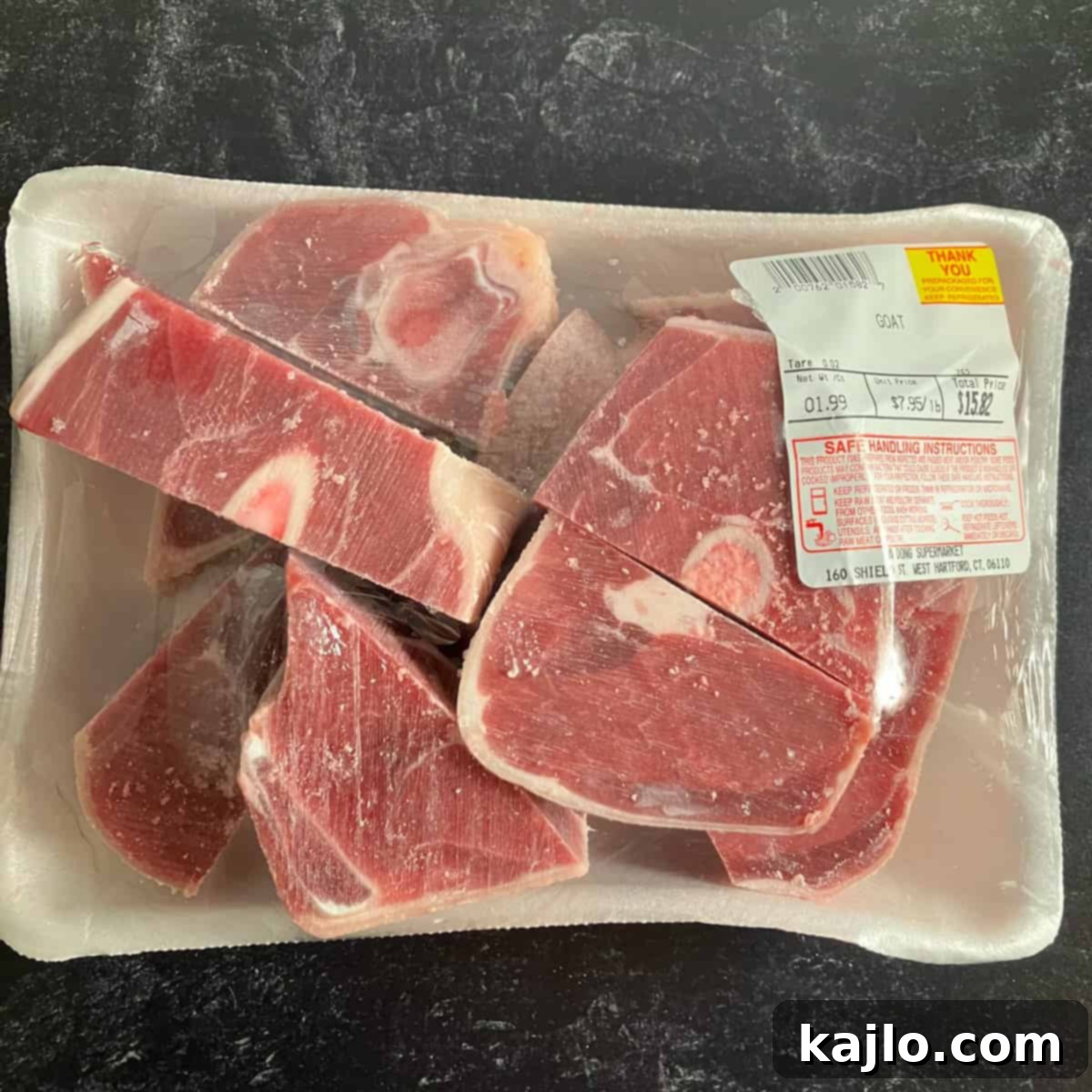
Another promising avenue is local farmer’s markets, especially those with vendors specializing in pasture-raised or heritage meats. While Amazon might not be a direct source for fresh goat meat, specialized online butchers and ethnic food delivery services are increasingly offering goat meat, often shipping it frozen directly to your door. A quick online search for “goat meat delivery” or “specialty meat online” might yield positive results.
Why is goat meat not widely sold in stores in the US? The primary reason for goat meat’s limited availability in typical US supermarkets is a combination of low domestic demand and challenges in supply. Unlike beef, pork, or chicken, goat is not yet a mainstream protein in the American diet, meaning there isn’t the consistent consumer demand to warrant widespread stocking. Furthermore, raising goats can be more challenging in terms of specific dietary and space requirements compared to other livestock, and the meat yield per animal is relatively lower. Sometimes, you might find imported goat meat, often from Australia or New Zealand, in larger specialty stores.
Even if retail options are scarce, don’t despair. Many Jamaican, Indian, and other ethnic restaurants frequently feature goat dishes on their menus, such as curried goat. Visiting these establishments can provide an excellent opportunity to sample goat meat and experience its deliciousness firsthand before attempting to cook it yourself.
Goat Meat Price: Understanding the Cost Factors
The price of goat meat can vary significantly based on your geographical location, the specific cut, and the vendor. In my experience, the last time I purchased goat meat, it was around $7.95 per pound. It’s common to find that specialty markets or farmers selling goat meat might not always have specific cuts readily available, often selling what they have in mixed pieces, usually bone-in, which is ideal for stews and curries.
Why Is Goat Meat So Expensive? Decoding Market Dynamics
Several factors contribute to goat meat’s higher price point compared to more common meats. Foremost is the limited supply in many Western markets. Goat farming for meat production is not as widespread or industrialized as cattle, pig, or chicken farming. This lower production volume naturally drives up costs. Additionally, goats have specific requirements for their diet and living space, and they yield less meat per animal compared to larger livestock. These agricultural and market dynamics collectively make goat meat a premium product, reflecting the specialized effort involved in bringing it to consumers.
How to Cook Goat Meat: Mastering Tender and Flavorful Dishes
Goat meat, with its lean profile and robust flavor, truly shines when cooked low and slow. This method allows the connective tissues to break down, resulting in incredibly tender meat that falls off the bone. While there are many ways to prepare goat, slow-cooked stews, curries, and braises are among the most popular and forgiving methods. Here, we present a delicious and easy-to-follow recipe for curried goat meat, a dish beloved in many cultures for its depth of flavor.
Ingredients for Goat Meat Curry:
- 2 lbs goat meat (bone-in, approximately 907 grams)
- 2 tablespoons olive oil
- 1 medium onion, chopped
- 2 tablespoons Jamaican curry powder (or a similar robust curry blend)
- ½ teaspoon dried thyme
- Salt and black pepper, to taste
- 2 cloves garlic, finely chopped
- 1 tablespoon freshly grated ginger
- ½ habanero pepper, minced (remove seeds for less heat, adjust to your preference)
- 2 large carrots, chopped
- 1 lb russet potatoes, chopped (approximately 454 grams)
- 1 cup low-sodium beef broth (or more as needed)
- Cooked rice for serving (optional, but highly recommended)
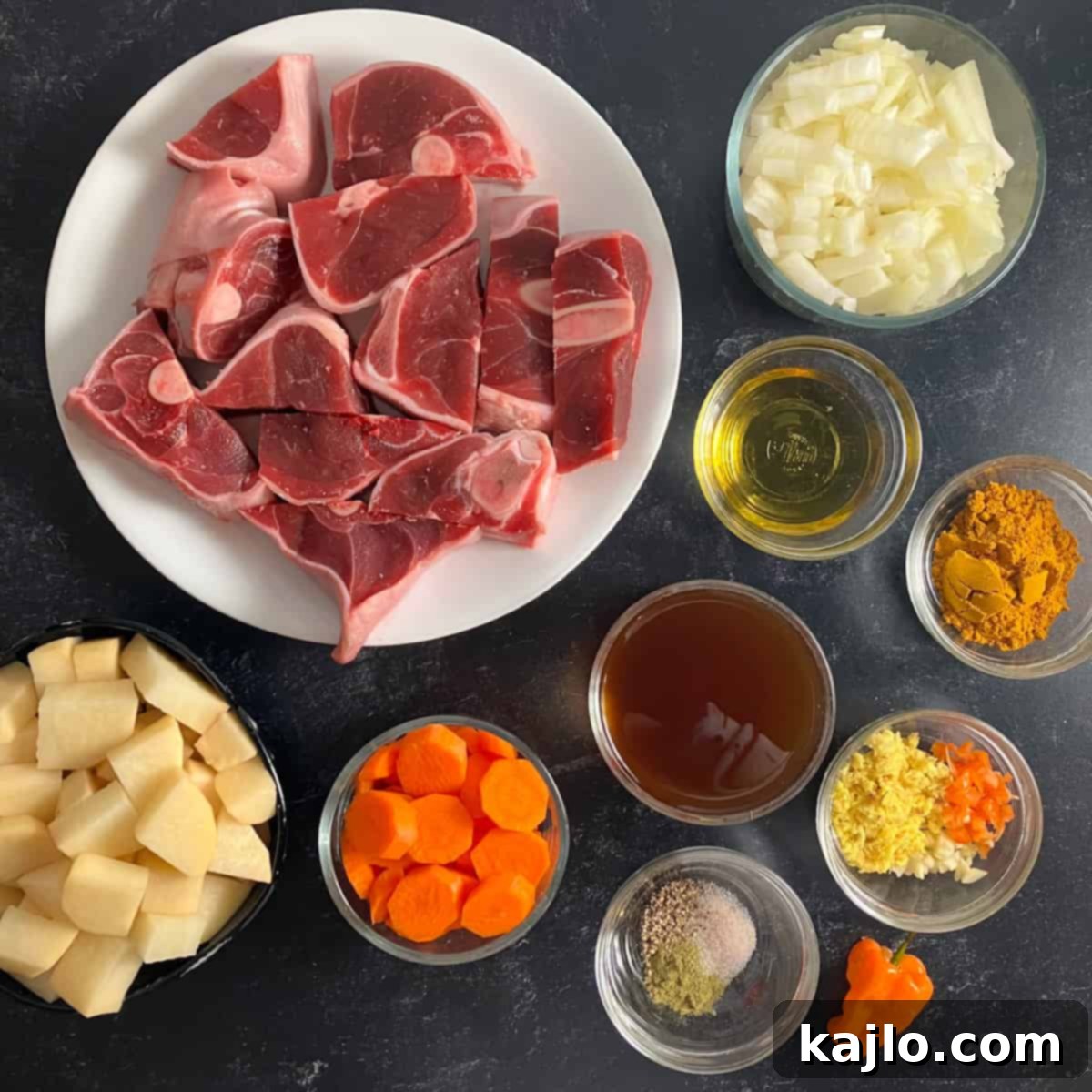
For equipment, you will need a large, heavy-bottomed pot (a Dutch oven works wonderfully), a sharp knife for chopping vegetables and meat, and a vegetable peeler. While cast iron is fantastic for many dishes, for this stew, I prefer a pot that allows for gentler simmering to prevent drying out too quickly and ensure the goat meat becomes exceptionally tender.
Recipe for Goat: Step-by-Step Curried Goat
Here are the detailed steps to prepare this aromatic and flavorful curried goat, ensuring a tender and rich dish:
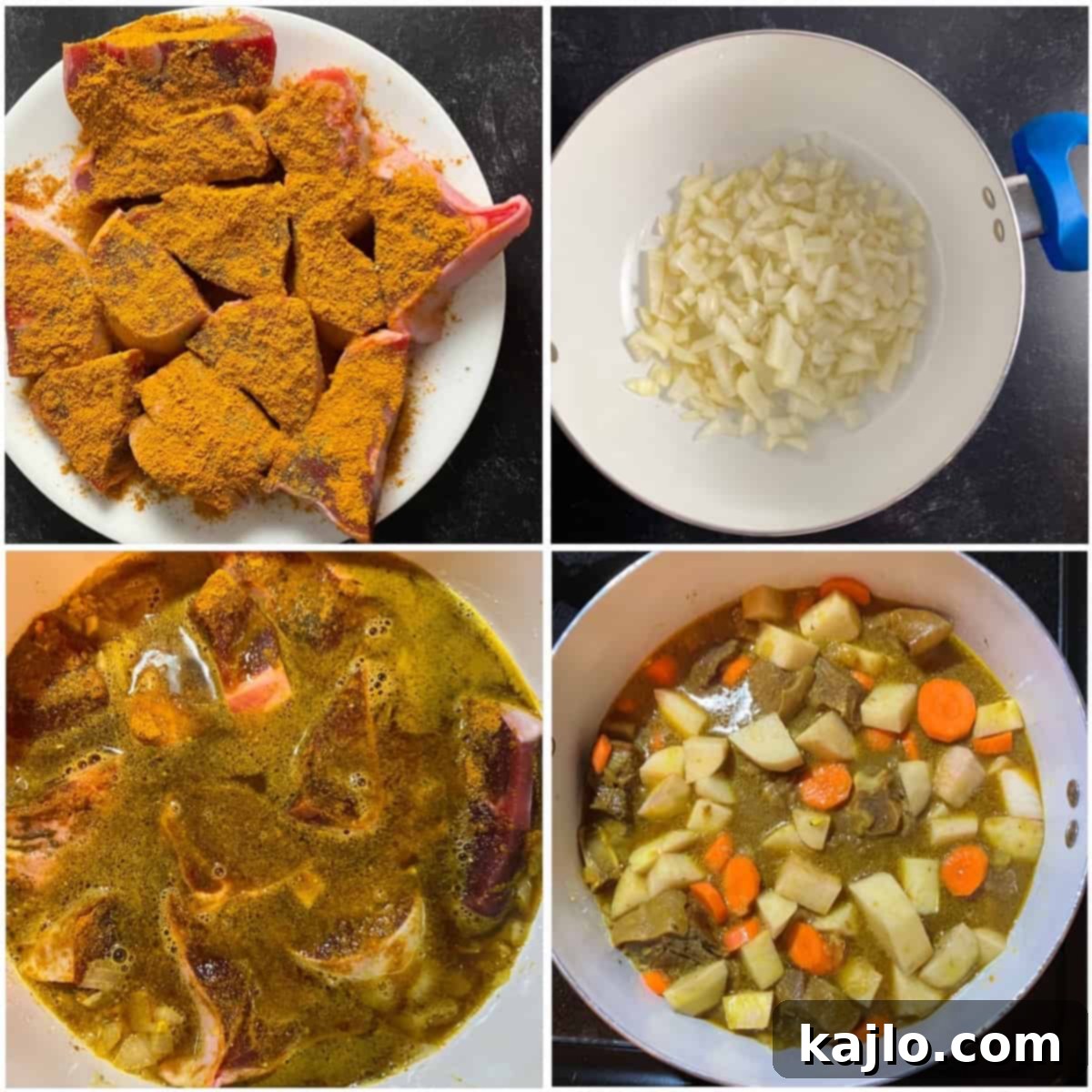
Begin by heating the olive oil in your large pot or Dutch oven over medium-high heat on the stovetop. Add the chopped onion and sauté for 5-10 minutes, stirring occasionally, until it softens and becomes translucent but not browned.
While the onion cooks, generously season both sides of your goat meat pieces with the Jamaican curry powder, dried thyme, salt, and black pepper. Ensure an even coating for maximum flavor infusion.
Add the finely chopped garlic, grated ginger, and minced habanero pepper to the pot with the softened onions. Cook for a brief 30-60 seconds until fragrant, being careful not to burn the garlic. Next, add the seasoned goat meat and beef broth to the pot. Stir well to combine. Cover the pot tightly and reduce the heat to medium-low. Allow the curry to simmer gently for 2 to 2½ hours. This long, slow cooking process is crucial for tenderizing the goat meat and developing a rich, thickened curry. Check the pot periodically to ensure there’s enough liquid, adding more broth if needed to prevent it from drying out.
While the goat meat is simmering, prepare your vegetables: peel and roughly chop the carrots and russet potatoes. Add these vegetables to the pot during the last 30-40 minutes of the cooking time. Bring the pot back to a simmer, then turn the heat to low, partially cover, and continue to cook until the carrots and potatoes are fork-tender.
Once cooked, serve this delightful goat curry hot, preferably over a bed of fluffy white or brown rice to soak up all the rich sauce. Enjoy the tender meat and aromatic spices!
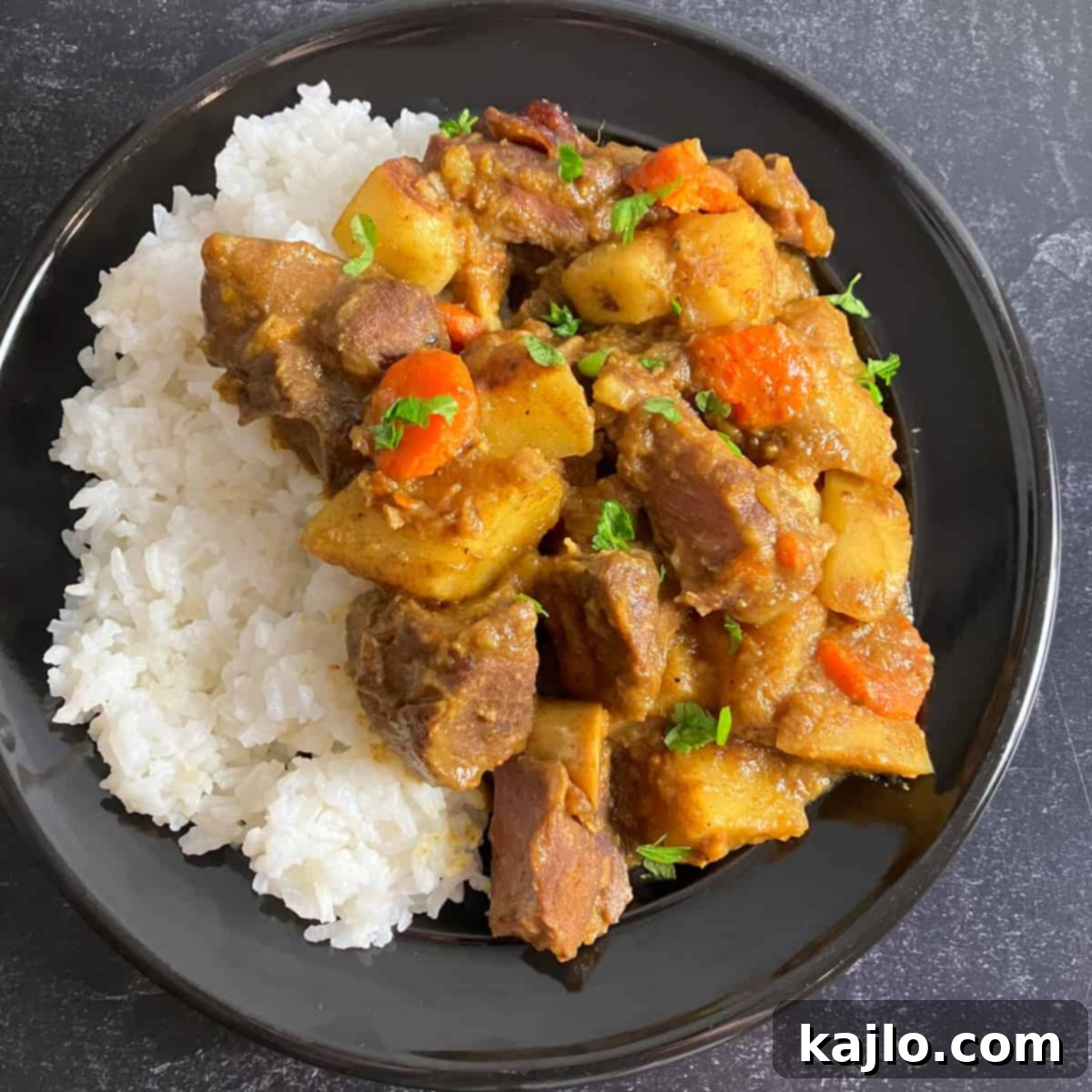
How Long Does Goat Take to Cook? Achieving Perfect Tenderness
For bone-in goat meat in a stew or curry, a cooking time of 2 to 2½ hours over medium to medium-low heat on the stovetop is generally ideal. Goat meat, being lean and often from mature animals, benefits immensely from a “low and slow” cooking approach. This extended simmering time allows the tough collagen in the meat to break down into gelatin, resulting in that desirable fall-off-the-bone tenderness and a rich, flavorful sauce.
Regarding food safety, the minimum internal temperature for cooked goat meat, similar to beef, is 145°F (63°C). However, when cooking goat for such an extended period in a braise or stew, you typically won’t need to use a meat thermometer. The long cooking duration ensures it easily surpasses the safe internal temperature, making it tender, safe, and delicious.
How to Season Goat Meat: Unlocking Its Full Flavor Potential
Seasoning is paramount to bringing out the best in goat meat, complementing its inherent bold flavor rather than masking it. In our curried goat recipe, a flavorful blend of Jamaican curry powder, fresh ginger, garlic, dried thyme, salt, and black pepper is used. The Jamaican curry powder is particularly noteworthy for its distinctive profile, often featuring prominent notes of fenugreek, turmeric, and coriander, which create a warm and complex base. I highly recommend seeking it out for an authentic flavor.

Beyond this specific curry, goat meat is incredibly versatile and pairs well with a wide array of spices and herbs. You can generally season goat with many of the same spices you would use for beef or lamb. Marinating goat meat is also an excellent strategy to tenderize it and infuse it with flavor, especially if you’re grilling or roasting. Consider these other seasoning ideas to explore:
- Cajun seasoning: For a spicy, savory kick.
- Jerk spices: Bringing the vibrant, aromatic flavors of the Caribbean.
- Italian seasoning: A classic blend of herbs like oregano, basil, and thyme.
- Parsley & Basil: Fresh herbs for brightness.
- Oregano & Rosemary: Earthy and aromatic, great for roasting.
- Allspice & Cumin: Deep, warm spices that enhance gamey flavors.
- Curry leaves & Scallion: Essential in many South Asian and Caribbean preparations.
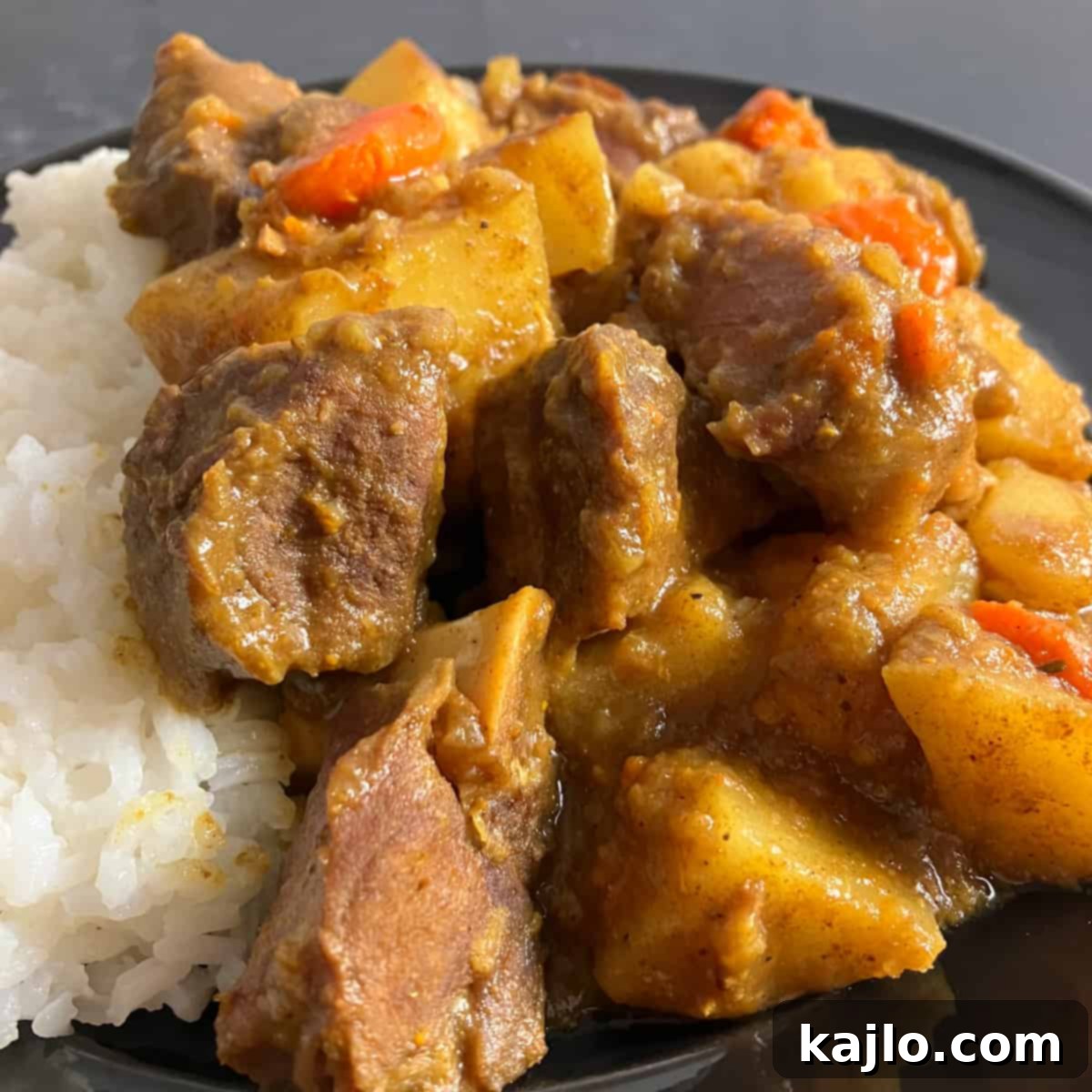
Frequently Asked Questions About Goat Meat
Which part of goat meat is best?
The “best” cut of goat meat largely depends on your intended cooking method. For slow-cooked dishes like stews, curries, and ragus, cuts from the neck, shoulder, and leg are excellent choices as they become incredibly tender with long cooking times. For grilling or roasting, more tender cuts like the loin or rump are often preferred. The leg is also versatile, suitable for braising or larger roasts. Each cut offers a unique texture and flavor profile when prepared appropriately.
Is goat meat a red meat?
Yes, goat is indeed classified as a red meat. This is due to its higher myoglobin content compared to poultry or fish. As highlighted in our nutritional comparison, cooked goat meat often contains more iron by weight than beef, further solidifying its status as a robust red meat.
Why do many in the US not eat goat meat?
The limited consumption of goat meat in the United States is somewhat of an anomaly, given its global popularity. Several factors contribute to this, including its higher price point compared to more common meats, and some Americans being unaccustomed to its distinct “gamey” flavor. There’s also a lack of widespread availability and cultural familiarity. However, this trend is slowly shifting as culinary horizons expand and awareness of its nutritional benefits grows. Historically, goats in the US were often raised for milk or fiber, not primarily for meat, unlike in many other parts of the world.
Is it legal to eat goat in the US?
Absolutely! It is perfectly legal to consume goat meat in the United States. The challenge lies not in legality, but in finding a consistent and accessible supply, as discussed in the “Where to Buy” section.
Can goat meat make you sick?
Like any type of meat, goat meat can potentially make you sick if it’s not handled or cooked properly. To ensure food safety, goat meat should be cooked to a minimum safe internal temperature of 145°F (63°C). It’s also crucial to practice safe food handling, such as avoiding cross-contamination and not leaving raw or cooked goat meat out at room temperature for more than 1-2 hours.
Which goat breeds are used for goat meat?
Several goat breeds are specifically raised for their meat, prized for their growth rate, meat-to-bone ratio, and carcass quality. Popular meat goat breeds include: Spanish goats, known for their hardiness and foraging ability; Boer goats, originating from South Africa, which are highly regarded for their fast growth and muscular build; Kiko goats, developed in New Zealand for their resilience; Myotonic goats (also known as “fainting goats”), valued for their meat and calm temperament; Savannah goats, another South African breed known for their robust nature; and Texmaster goats, a crossbreed developed for improved meat production.
More Delicious Goat Meat Recipes to Try
Once you’ve experienced the rich flavors of curried goat, you might be eager to explore other ways to enjoy this incredible meat. Goat meat is incredibly versatile and can be grilled, stewed, roasted, and much more. Here are a couple of additional recipes to inspire your culinary adventures with goat:
- African Goat Stew: A hearty and flavorful stew, often featuring a medley of vegetables and aromatic spices unique to African cuisine.
- Greek Slow Roasted Goat: A classic preparation that highlights the tenderness of goat, often seasoned with lemon, garlic, and Mediterranean herbs.
Watch How to Make It!
(Video content unavailable in this HTML-only format. Please refer to original source for video.)

Goat Meat (Recipes, Where to Buy, Price, Benefits, more!)
Summer Yule
★★★★★ (5 out of 5 stars from 2 votes)
Print Recipe
Pin Recipe
2 hrs
2 hrs
Dinner
Jamaican
4
502 kcal
Ingredients
- 2 lbs goat meat bone in, 907 grams
- 2 tablespoons olive oil
- 1 medium onion, chopped
- 2 tablespoons Jamaican curry powder
- ½ teaspoon dried thyme
- salt and pepper, to taste
- 2 cloves garlic, finely chopped
- 1 tablespoon fresh grated ginger
- ½ habanero pepper, finely chopped (remove seeds if less heat is your preference)
- 2 large carrots, chopped
- 1 lb russet potatoes, chopped 454 grams
- 1 cup low-sodium beef broth (and more as needed)
Instructions
- Put the oil in a pot on the stovetop and set the heat to medium high. Add the onion and cook for 5-10 minutes, until softened but not browned.
- Sprinkle both sides of the goat meat pieces with curry powder, thyme, salt, and black pepper.
- Add the garlic, ginger, and habanero to the pot and cook for 30-60 seconds. Next, add the seasoned goat and beef broth to the pot. Cover the pot and simmer on medium heat for 2-2½ hours until the curry is thickened and the goat is tender. Check the pot occasionally to adjust the heat and add more broth if more moisture is needed.
- While the goat cooks, peel and roughly chop the carrots and potatoes. Add the vegetables to the pot 30-40 minutes before the end of the cooking time. Bring the pot to a simmer, turn the heat to low, partially cover the pot, and cook until the veggies are tender.
- Serve this delicious goat curry over cooked rice, if desired.
Equipment
- Large Pot
- Knife
- Peeler
Notes
💭 Expert Tips from Dietitian Summer Yule
This is a level 1 recipe (may help support fat loss). Is goat meat healthy? Goat meat is a low calorie lean protein packed with B complex vitamins, iron, phosphorus, and zinc. I have no qualms calling it healthy in terms of nutrient density.
As with oxtail, most cuts of goat you buy in the US contain a lot of bones. This makes this food fun to eat, because sometimes it’s best to use your fingers. As an added bonus, the high bone to meat ratio helps to provide portion control.
Because so much is unknown (and disputed) about nutrition, I like to eat as I like to invest- with a diversified plan. Getting a variety of healthy whole foods in your diet can help ensure you’re getting the widest variety of beneficial phyto- and zoonutrients possible. It matters less if one food ends up being “good” or “bad” in the newest study, because each food is only a small part of your total diet.
One fun way to diversify your nutrition portfolio is to grab the opportunity to try new foods. Goat is a food many in the US haven’t sampled yet. I hope this post inspires you to try it!
Nutrition information is for one serving.
nutrition info disclaimer
All recipes on this website may or may not be appropriate for you, depending on your medical needs and personal preferences. Consult with a registered dietitian or your physician if you need help determining the dietary pattern that may be best for you.
The nutrition information is an estimate provided as a courtesy. It will differ depending on the specific brands and ingredients that you use. Calorie information on food labels may be inaccurate, so please don’t sweat the numbers too much.
“To taste” means to your preferences, which may have to be visual to follow food safety rules. Please don’t eat undercooked food x
Nutrition
curried goat, curried goat meat, curry goat, goat curry, goat meat, goat meat recipe, goat meat recipes, goat recipe, goat recipes, how to cook goat, how to cook goat meat
Join our community! Subscribe for all of the latest and greatest recipes, and follow me on Facebook, Pinterest, Instagram, and YouTube!
